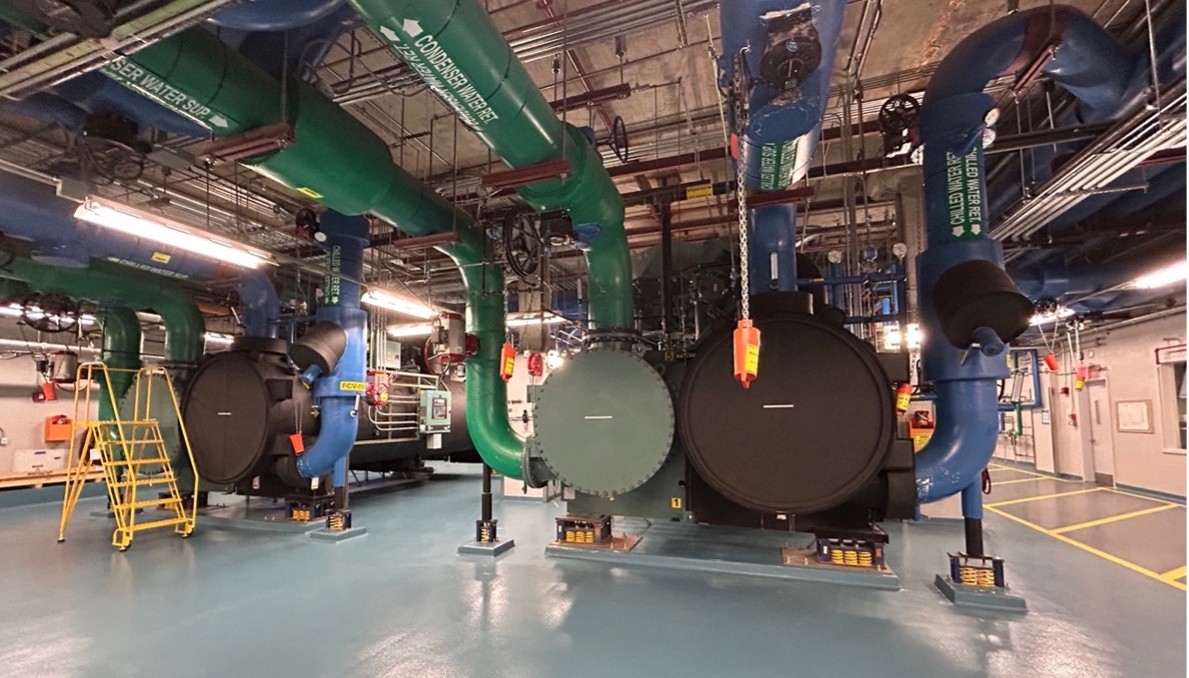Columbia’s Progress on Electrification and Energy Initiatives
Progress over the recent calendar year on electrification, retro-commissioning, LED lighting, data collection, and more all contribute to Columbia’s road to net zero emissions.

Over the past year, Columbia has made significant strides in its energy management and greenhouse gas (GHG) reduction efforts. With the commitment to reach net zero by 2050 and science-based targets (SBT) to measure incremental progress, the University’s aggressive stance on tackling climate change requires a gamut of strategies and tactics including electrification, retro-commissioning, lighting and technology upgrades, and more.
Electrification
As of 2022, 57% of the University’s Scope 1 emissions were attributed to the combustion of fuel in our buildings, which translates to 122,207 Metric tons of CO2 equivalent (MtCO2e). As part of the University’s plan to reduce those emissions to remain on an aggressive pathway to net zero by 2050 or sooner, a series of engineering studies have been employed for all real estate portfolios to help plan the transitions for Morningside’s central plant, graduate and residential buildings, Manhattanville’s central plant, Medical Center and LDEO campus buildings.
The Morningside Campus electrification study was completed in 2023. To lay the foundation for the work ahead, this year the team has begun designs for initial electrification upgrades at the Morningside Campus; a process that will require time, resources, and disruption to campus life – but is essential for meeting the University’s net zero target.
The Strategic Electrification Study for the Manhattanville Central Plant is nearing completion and is expected to be finished this year. The plan defines concepts for decarbonizing the existing plant while leveraging opportunities for ground source heating and cooling as the campus expands. The Strategic Electrification Study for the residential and undergraduate housing portfolios is in progress and is expected to be complete this summer.
Collectively, these portfolios must work together to achieve the emissions targets set forth in Plan 2030.
Energy-Saving Measures
Facilities and Operations completed its review and maintenance of 296 sub-meters at the Morningside and Manhattanville campuses. Over one thousand retro-commissioning measures in 33 buildings on the Morningside and Manhattanville campuses have been identified and will be implemented over the coming 18 months.
LEARN MORE
LED lighting upgrade designs have been completed for Baker Field, the School of Social Work, the Studebaker building, and Furnald Hall. Implementation of the work at Baker Field and SSW will commence this spring. LED lights consume less electricity than incandescent bulbs and are much cooler, reducing the risk of combustion. LEDs are also much sturdier, as they are made with epoxy lenses, not glass, so they’re much more resistant to breakage.
Columbia insulated 3,700 linear feet of steam piping and installed over 1,600 steam insulation jackets on steam valves, traps, and other devices, all of which reduce energy losses and lower overall steam demand. The results of the project avoided 1,200 metric tons of CO2 emissions per year.
This year saw record participation in Demand Response programs, resulting avoided emissions of 80 metric tons of CO2. Demand Response programs offered by Con Edison and New York Independent System Operator (NYISO) are voluntary reductions or shifts in electricity usage during times of high electric grid demand. During periods of peak demand, Morningside, Manhattanville, and Lamont Doherty campuses reduce demand on the grid by placing alternate pieces of equipment in service and modifying how chilled water is supplied to the campus buildings. This year’s performance was nearly three times better than the previous best-performing year.
In 2023, Columbia also defined and selected a software platform for collecting, analyzing, and dashboarding University-wide utility and metering data. The platform will be implemented over the coming year. Together with the ongoing initiative to enhance our existing metering network, this platform is expected to significantly streamline data gathering and improve visibility of the University’s energy consumption.
